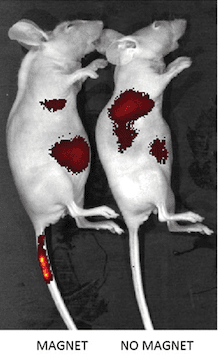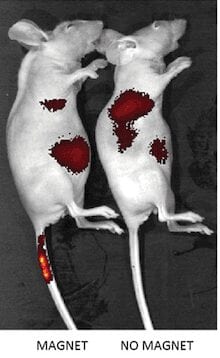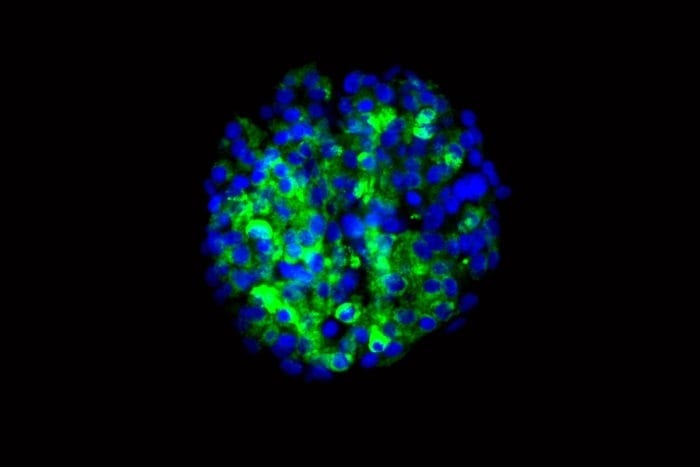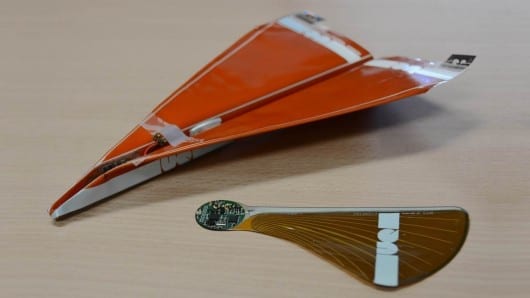
Magnets could be a tool for directing stem cells’ healing powers to treat conditions such as heart disease or vascular disease.
By feeding stem cells tiny particles made of magnetized iron oxide, scientists at Emory and Georgia Tech can then use magnets to attract the cells to a particular location in a mouse’s body after intravenous injection.
The results are published online in the journal Small and will appear in an upcoming issue.
The paper was a result of collaboration between the laboratories of W. Robert Taylor, MD, PhD, and Gang Bao, PhD. Taylor is professor of medicine and biomedical engineering and director of the Division of Cardiology at Emory University School of Medicine. Bao is professor in the Wallace H. Coulter Department of Biomedical Engineering at Georgia Tech and Emory University. Co-first authors of the paper are postdoctoral fellows Natalia Landazuri, PhD, and Sheng Tong, PhD. Landazuri is now at the Karolinska Institute in Sweden.
The type of cells used in the study, mesenchymal stem cells, are not embryonic stem cells. Mesenchymal stem cells can be readily obtained from adult tissues such as bone marrow or fat. They are capable of becoming bone, fat and cartilage cells, but not other types of cell such as muscle or brain. They secrete a variety of nourishing and anti-inflammatory factors, which could make them valuable tools for treating conditions such as cardiovascular disease or autoimmune disorders.
Magnetized iron oxide nanoparticles are already FDA-approved for diagnostic purposes with MRI (magnetic resonance imaging). Other scientists have tried to load stem cells with similar particles, but found that the coating on the particles was toxic or changed the cells’ properties. The nanoparticles used in this study have a polyethylene glycol coating that protects the cell from damage. Another unique feature is that the Emory/Tech team used a magnetic field to push the particles into the cells, rather than chemical agents used previously.
“We were able to load the cells with a lot of these nanoparticles and we showed clearly that the cells were not harmed,” Taylor says. “The coating is unique and thus there was no change in viability and perhaps even more importantly, we didn’t see any change in the characteristics of the stem cells, such as their capacity to differentiate. This was essentially a proof of principle experiment. Ultimately, we would target these to a particular limb, an abnormal blood vessel or even the heart.”
The Latest Bing News on:
Steering stem cells
- Alexis Thompson: advancing care for sickle cell diseaseon April 30, 2024 at 7:16 pm
Alexis Thompson's career spans bench to beside and reached a historic milestone in 2023, with the approval of the first two gene therapies for sickle cell disease. Now Chief of the Division of ...
- Study uncovers the secret of long-lived stem cellson April 30, 2024 at 1:20 pm
Nothing lives forever, but compared to other cells in the body, hematopoietic stem cells (HSCs) are remarkably long-lived. HSCs are blood-forming cells—they give rise to rapidly dividing progenitor ...
- Unlocking the secrets of long-lived hematopoietic stem cellson April 29, 2024 at 5:00 pm
Nothing lives forever, but compared to other cells in the body, hematopoietic stem cells (HSCs) are remarkably long-lived. HSCs are blood-forming cells – they give rise to rapidly dividing progenitor ...
- Stem cells improve memory, reduce inflammation in Alzheimer's mouse brainson April 29, 2024 at 10:27 am
When people think of Alzheimer's Disease and possible treatment, amyloid—and the accumulation of plaques that invade the cerebral cortex—is often brought up first. However, scientists are finding that ...
- How Kyriakos Mitsotakis Is Shaking Up the Greek Economyon April 29, 2024 at 9:23 am
Mitsotakis is addressing his followers on TikTok, where his account so successfully showcases his softer side that it has brought his team a national award. “We are very biased, but I honestly believe ...
- In a First, Neurons from Rat Stem Cells Regenerate Brain Circuits in Miceon April 26, 2024 at 7:49 am
Two independent research teams have successfully regenerated mouse brain circuits in mice using neurons grown from rat stem cells.
- Why a balanced scalp microbiome is key to getting healthy, thick hairon April 26, 2024 at 6:58 am
If you’re already taking a pre- or probiotic, then you’ll be aware of the positive impact of balancing your biome. Now, our relatively recent preoccupation with gut health and how bacteria can ...
- In a first, mice brain circuits regenerated using rat stem cellson April 25, 2024 at 8:29 am
Two independent research teams have achieved successful regeneration of mouse brain circuits by cultivating neurons from rat stem cells.
- Researchers publish final results of key clinical trial for gene therapy for sickle cell diseaseon April 25, 2024 at 6:14 am
In a landmark study, an international consortium led by researchers at Children's Hospital of Philadelphia (CHOP) published the final results of a key clinical trial of the gene therapy CASGEVY ...
- CASGEVY gene therapy eliminates vaso-occlusive crises in sickle cell patientson April 24, 2024 at 11:33 pm
In a landmark study, an international consortium led by researchers at (CHOP) published the final results of a key clinical trial of the gene therapy CASGEVY (exagamglogene autotemcel) for the ...
The Latest Google Headlines on:
Steering stem cells
[google_news title=”” keyword=”Steering stem cells” num_posts=”10″ blurb_length=”0″ show_thumb=”left”]
The Latest Bing News on:
Directing stem cells
- Study uncovers the secret of long-lived stem cellson April 30, 2024 at 1:20 pm
Nothing lives forever, but compared to other cells in the body, hematopoietic stem cells (HSCs) are remarkably long-lived. HSCs are blood-forming cells—they give rise to rapidly dividing progenitor ...
- Stem Cells Newson April 27, 2024 at 5:00 pm
When the team transplanted bone marrow stem cells from mice carrying a hereditary version of Alzheimer's disease into normal lab mice, the recipients ... Apr. 22, 2024 — Physical cues in the ...
- Cancer Breakthrough Found to Boost Immune Cells Without Harmful Side-Effects By Directing Protein Cytokineson April 21, 2024 at 7:00 am
A new way to safely boost immune cells to fight cancer—avoiding harmful side-effects such as hair loss—has been developed.
- Study shows potential for universal flu vaccine with broad antibody responseon April 15, 2024 at 7:52 pm
Study discusses the potential of universal influenza vaccines, emphasizing the importance of antibody breadth and Fc receptor (FcR) effector functions in protecting against various influenza strains, ...
- BME 495-0-07: Regenerative Engineering Labon August 6, 2023 at 1:51 am
They will also gain hands-on experience in designing and conducting experiments to study the behavior and properties of stem cells, and in developing strategies for directing stem cell differentiation ...
- Nanotechnology Degree Programson November 3, 2022 at 3:54 am
Project topics include: nanoparticle targeted drug delivery, imaging and therapy; trachea, nose, ear, cardiovascular, skin and bone tissue engineering; functionalised scaffolds for directing stem cell ...
- Melissa L. Harrison January 6, 2022 at 8:05 am
Research Interests: Somatic Stem Cells and Aging, Genetic Mechanisms of Stem Cell Maintenance ... Here she used the chick embryo as a model to investigate the role of transmembrane receptors in ...
- What is Peter Jackson's Net Worth?on August 16, 2020 at 10:34 am
He first gained notice for writing and directing a series of "splatter ... Jackson's charitable activities include giving NZ $500,000 to stem cell research, saving an old church in Wellington ...
- Research and principal investigatorson March 30, 2019 at 7:26 pm
We have identified and isolated a population of multipotent otic stem cells from the human fetal cochlea and established them as cell lines. We have devised ways of directing differentiation of human ...
- Directing Fate and Age of Human Pluripotent Stem Cellson August 20, 2018 at 6:15 pm
Right panels: Lab-grown cortical interneurons from human pluripotent stem cells are tools to study psychiatric disorders. Specific functional, electric firing properties of those neurons are shown by ...
The Latest Google Headlines on:
Directing stem cells
[google_news title=”” keyword=”directing stem cells” num_posts=”10″ blurb_length=”0″ show_thumb=”left”]











